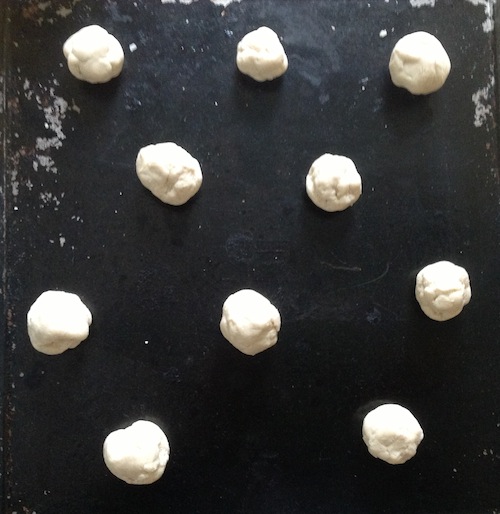Talking Math with Other People’s Kids Month rolls along…
Jennifer Lawler wrote up the following conversation on her blog.
—
Jennifer is in the kitchen baking chocolate chip cookies when her son Ian (8 years old) wanders in and observes her methods. She has put three balls of cookie dough in a row, two balls of dough in the next row, and is beginning a new row.
Ian (8 years old): Are you going to put three in the next row?
Mom: Yep.
Ian: And then two in the last row?
Mom: Yep…How many cookies are on the tray?
Simulated cookie dough. Shout out to anyone who can ID the actual substance in this photo.
Ian: Ten.
Mom: How do you know that?
Ian: Three plus three is six, and two plus two is four, and six plus four is ten.
Mom: Hmm….my brain immediately puts the three and two together to make 5 and then adds the 5s together.
Mom: The recipe days it makes 5 dozen cookies. How many is that?
Ian: So that’s 5 12′s?
Mom: Yes.
Ian: 36? No…24 plus… No, wait. 60.
Mom: Ok, I made a double batch, so how many is that?
Ian: 120
Mom: And if there’s 10 on a tray, how many trays of cookies will that be?
Ian: 12
Mom: I have three cookie sheets, so how many times will I have to put each tray in the oven?
Ian: 12 divided by 3 is 4 – four times.
So what do we learn?
What I love about this conversation is that every question is an authentic one that someone baking cookies might consider along the way. I love that Jennifer keeps asking questions until she hits one that forces Ian to think, and I love that she offers Ian a different way to view the cookies on the tray (2 fives instead of 6+4). This last bit sends an important message—that math ideas are something we talk about, not just memorized facts.
Most of the time when people think about the math involved in baking, it’s the fractions. Fractions of a cup and of a teaspoon are fine. But we don’t actually do much math with them. If I need , I usually measure 3 cups and then use the
cup measure. It’s counting the whole way. This is good, and it’s useful for helping children become accustomed to the relative sizes of fractions, and to the language surrounding them. But there isn’t as much mathematical thinking going on as when Jennifer asks Ian how many cookies are in 5 dozen, or to say how he knows how many cookies are on a tray with a 3-2-3-2 pattern.
Starting the conversation
Baking together is a great opportunity for asking how many? questions of various forms. Ask your child to put things in rows, or to count things that already are. Guess how many chocolate chips are in each cookie, and then in the whole batch. Compare to the expected number of raisins in an oatmeal cookie.
All along the way, listen to your child’s thinking and offer your own ideas. Make it a conversation.
Tabitha and I had a blast a while back arranging crackers and pepperoni in rows. Just like Jennifer and Ian, we predicted how things would come out and enjoyed talking and cooking together.

